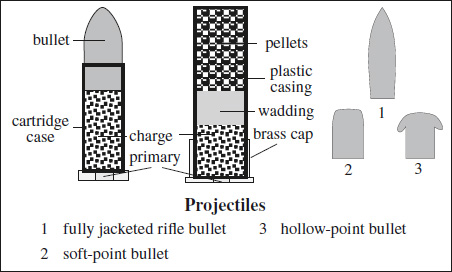Bone and Soft-Tissue Disorders
Prevalence: 200,000 gun-related injuries per year; 31,224 firearm-related deaths in USA (2007)
Firearms: handgun, rifle (great energy), shotgun
Projectiles:
- bullet:
- jacketed bullet with mantle of copper
- semi jacketed bullet = exposed lead at tip
- non jacketed bullet
- pellets of steel / lead:
- birdshot = small pellets
- buckshot =large pellets
Assessment of type of projectile:
- fully jacketed bullets show no trail of lead fragments
- semi- / non jacketed bullets distribute lead fragments along bullet track
- hollow-point bullets transform into mushroom shape
- “lead snowstorm” of high-velocity soft-point rifle bullets:
- conical distribution with apex pointing toward entry site
- steel pellets remain round, lead pellets become deformed + fragmented

Assessment of trajectory:
- bullet tips points to entry wound (after tumbling through 180°):
- impact deformation of bullet modifies tumbling
- bullet + bone fragments deposited along track
- bone fracture beveled toward the direction of travel
Location: liver >small bowel >colon >spleen >kidney >pancreas
Pathophysiology of gunshot: complex interaction of mass, velocity, path, type of organ
- projectile: bullet imparts kinetic energy to surrounding tissue → tissue displacement radially away from path of bullet → temporary cavity much larger than bullet diameter (depending on mass, material, design, velocity of projectile)
- tissue: damage depends on specific gravity (density) and elasticity of type of soft tissue ↓ density + ↑ elasticity: skin, lung (less damage) ↑ density + ↓ elasticity: liver, spleen, muscle
- fluid: pressure wave → bursting of fluid-filled organ
- bone: bone fragments = numerous secondary missiles
Cx: pellet embolization, magnetization in MRI